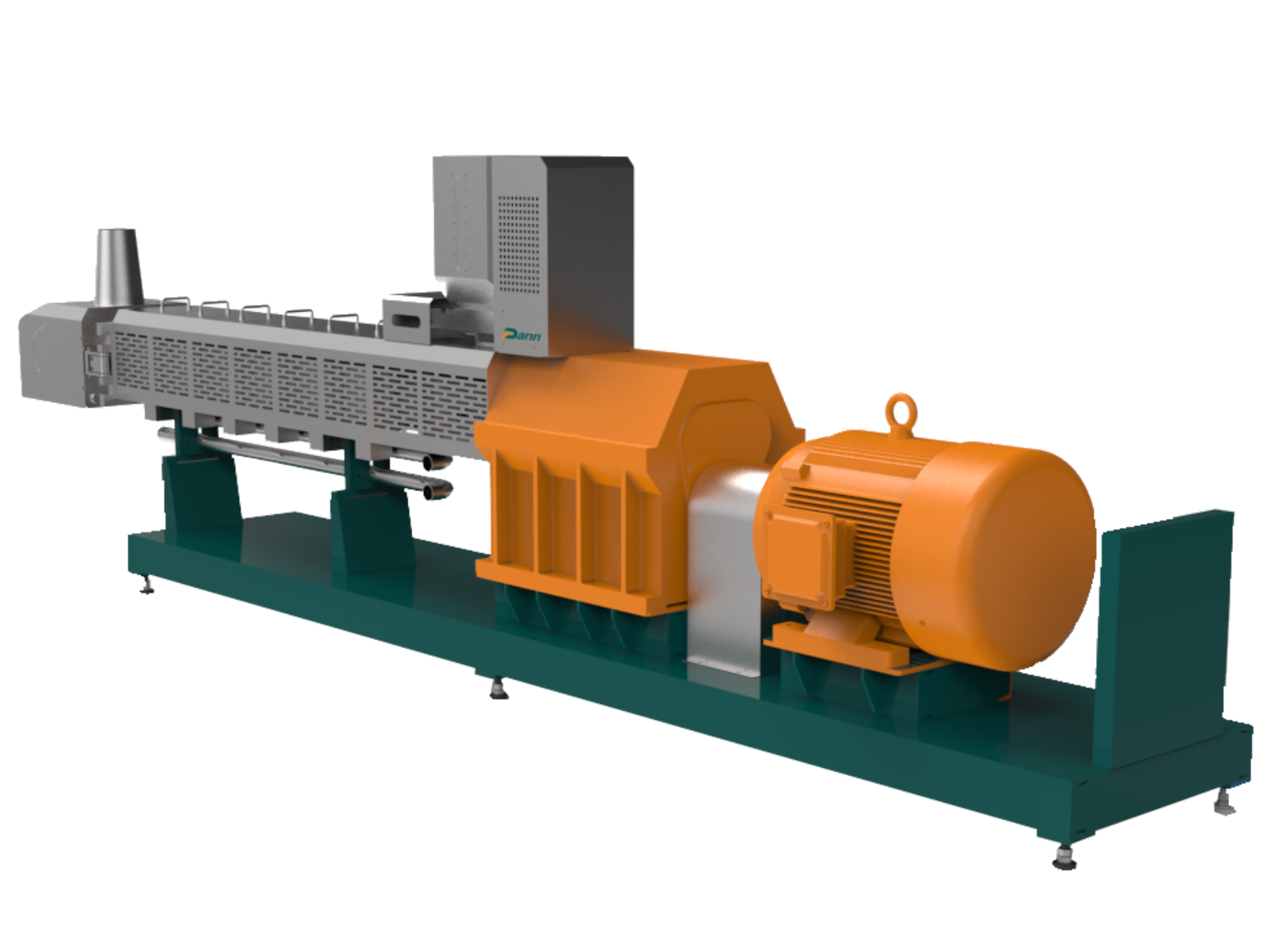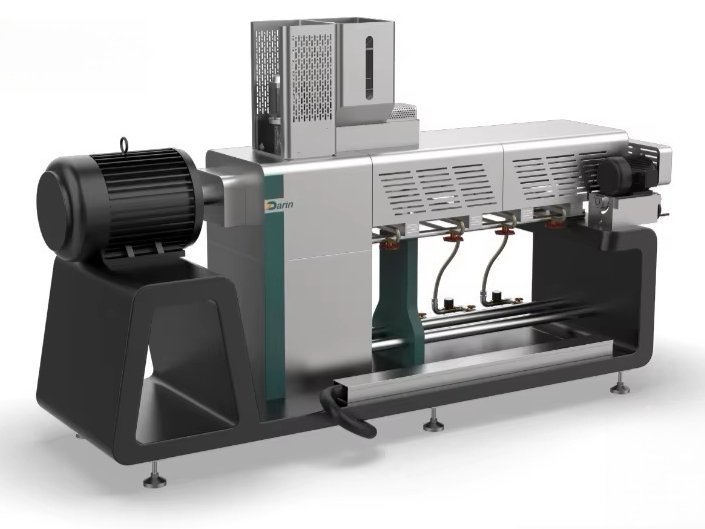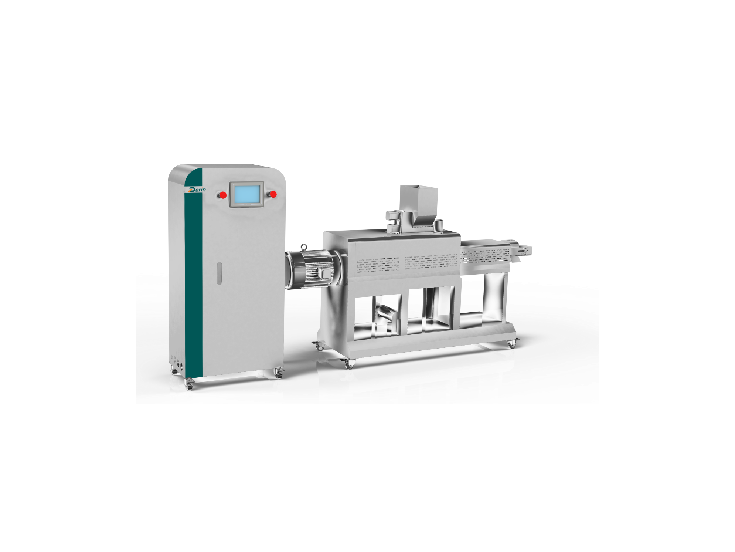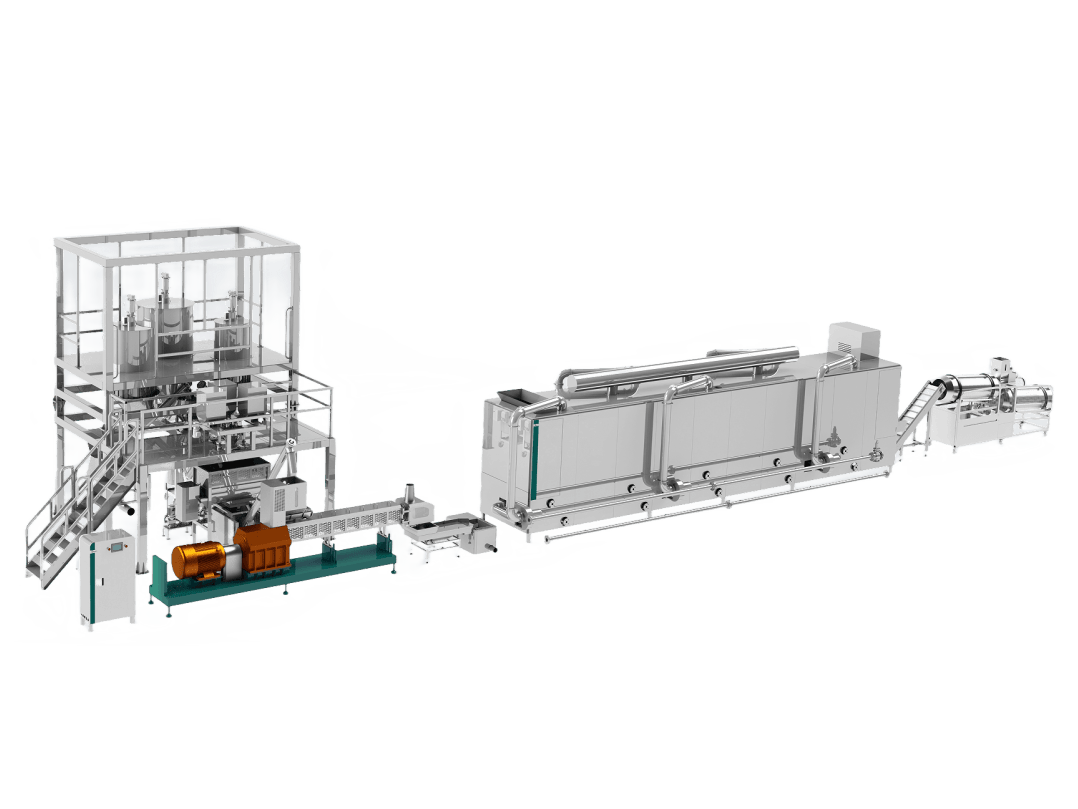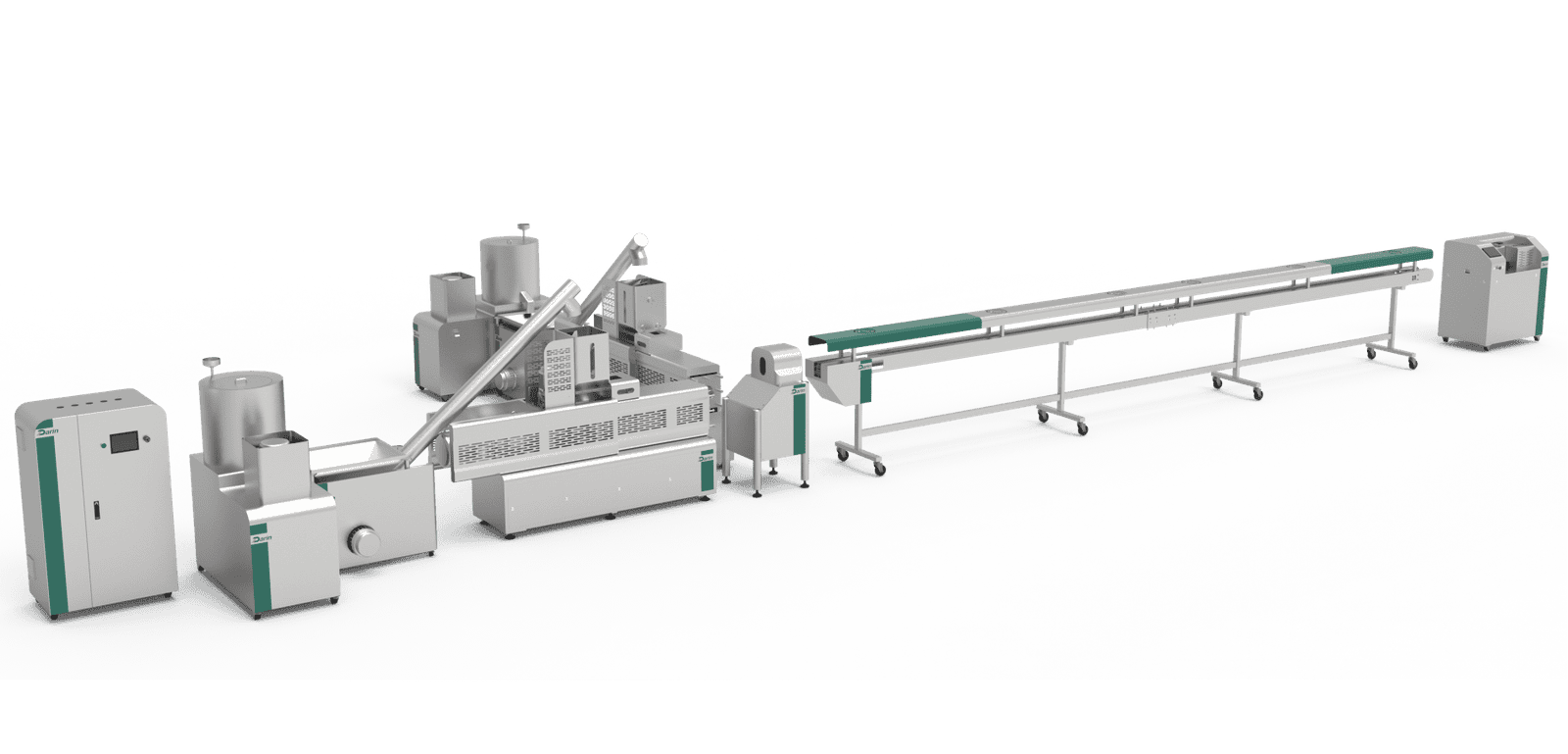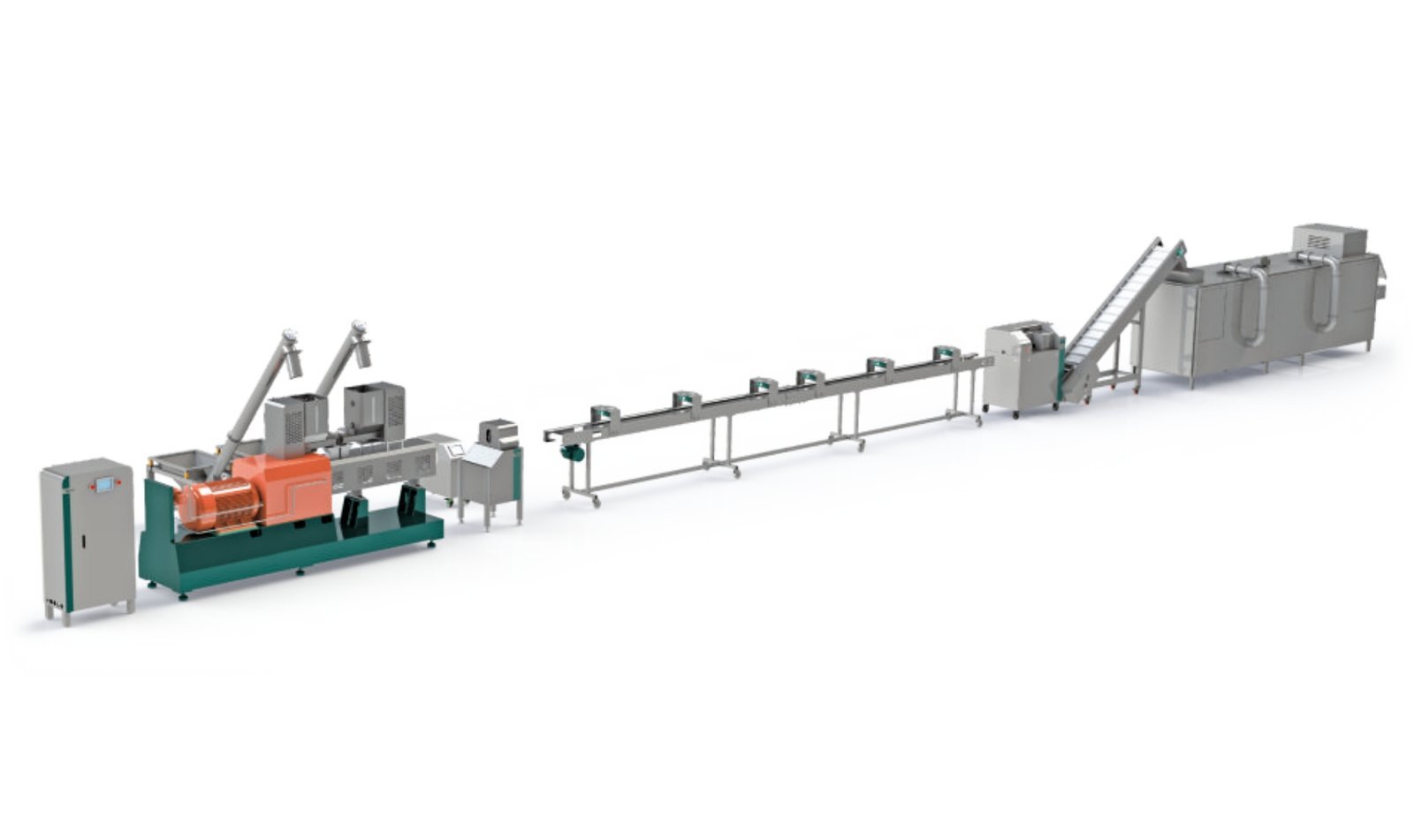
Dog chew production is one of the most dynamic and technology-driven segments in the pet food industry today. As consumer demand grows for high-quality, safe, and diverse chew products, manufacturers face a critical challenge: how to produce efficiently, consistently, and cost-effectively while maintaining flexibility across chew types. Without the right machines, production can become inconsistent, energy-intensive, and prone to quality defects like uneven texture, moisture imbalance, or poor shape formation.
An efficient dog chew production line typically includes the following essential machines: mixer, screw conveyor, twin-screw extruder, forming and cutting system, cooling conveyor, multi-layer dryer, flavoring/coating machine, and automatic packaging system. Each machine plays a specific role in ensuring consistent product texture, optimal moisture, hygienic processing, and stable output.
The following sections provide a detailed breakdown of each machine, its working principle, function, and technical considerations — enabling you to design or optimize a professional, high-efficiency dog chew factory layout.
Dog chew production lines can operate efficiently without an extruder.False
The extrusion process is essential for shaping, gelatinization, and achieving consistent texture and density in most modern dog chews.
1. Ingredient Mixing System
The first and one of the most critical steps in dog chew production is uniform mixing of ingredients such as starch, protein, glycerin, collagen, and functional additives.
| Machine Name | Function | Technical Notes |
|---|---|---|
| Ribbon Mixer | Blends dry and wet ingredients uniformly | Equipped with stainless steel paddles and discharge valves |
| High-Speed Mixer | Improves blending efficiency for viscous materials | Ideal for collagen or meat-based formulas |
| Vacuum Mixer (Optional) | Prevents oxidation and maintains color | Recommended for premium or functional chews |
A well-mixed formula ensures even cooking in the extruder and prevents texture defects later in production.
2. Screw Conveyor
Once mixed, the material must be transferred safely and hygienically to the extruder. Screw conveyors or augers are used to transport material automatically, minimizing manual handling and contamination risk.
| Component | Purpose |
|---|---|
| Stainless Steel Screw | Moves material from mixer to extruder inlet |
| Closed Tube Design | Prevents dust and contamination |
| Variable Speed Motor | Controls feed rate precisely |
Automatic transfer improves line continuity and overall output efficiency.
3. Twin-Screw Extruder — The Heart of Dog Chew Production
The twin-screw extruder is the core machine that determines product quality, texture, density, and shape. It thermally and mechanically processes the mixture, transforming raw materials into homogeneous, shaped dough.
| Main Function | Gelatinization, shaping, and texturizing |
|---|---|
| Key Parameters | Barrel temperature (80–180°C), screw speed (200–600 rpm) |
| Material Feeding Rate | 80–500 kg/h (depending on model) |
| Output Forms | Stick, bone, twist, ring, dental, filled chews |
| Control System | PLC + touch screen (Siemens/Delta) |
Advantages of Twin-Screw Extrusion
- Continuous, high-efficiency operation
- Automatic temperature and torque control
- Flexibility for multiple formulations (starch, collagen, or mixed base)
- Uniform product texture and expansion
Single-screw extruders are better than twin-screw extruders for dog chew production.False
Twin-screw extruders offer superior mixing, temperature control, and flexibility for multi-ingredient pet chew formulations.
4. Forming and Shaping System
After extrusion, the hot, semi-molten product must be shaped into desired forms. This is achieved by different dies and cutting mechanisms that define the product’s final appearance.
| Machine | Description | Shape Options |
|---|---|---|
| Forming Die Head | Determines cross-sectional shape (bone, stick, ring) | Customizable stainless-steel molds |
| Rotary Cutter / Guillotine Cutter | Cuts products into equal lengths | Adjustable speed for uniform cutting |
| Co-Extrusion Head (Optional) | Enables dual-color or filled products | For stuffed or layered chews |
Example Shapes
- Single-color bone
- Dual-color dental stick
- Filled pillow or tube
- Braided or twisted shapes
Precise forming ensures both aesthetic appeal and uniform drying performance.
5. Cooling Conveyor
Extruded chews exit the die at high temperatures (~90–130°C) and must be cooled to stabilize their structure before drying.
| Component | Function |
|---|---|
| Cooling Belt Conveyor | Transfers and cools products using air fans |
| Stainless Steel Mesh Belt | Allows uniform airflow and hygienic operation |
| Adjustable Length (2–6 m) | Based on output and product size |
Cooling prevents deformation and ensures surface hardness consistency.
6. Multi-Layer Dryer
Drying is one of the most energy-sensitive and quality-defining processes in chew production. Multi-layer belt dryers or circulating hot-air dryers are standard solutions.
| Dryer Type | Application | Temperature Range | Drying Time |
|---|---|---|---|
| Electric Hot-Air Dryer | For starch or collagen chews | 60–120°C | 2–5 hours |
| Steam Dryer | For energy-efficient large plants | 70–100°C | 3–6 hours |
| Gas-Fired Dryer | For high-capacity systems | 80–130°C | 1.5–3 hours |
Technical Considerations
- Maintain uniform airflow across layers
- Use food-grade stainless steel trays
- Integrate humidity sensors for precise moisture control
| Key Performance Data | Target Value |
|---|---|
| Final Moisture Content | 8–12% |
| Energy Efficiency | ≥85% |
| Drying Uniformity | ±2% moisture difference |
Proper drying ensures long shelf life and prevents mold growth during storage.
7. Flavoring and Coating System
After drying, chews can be coated with flavors, oils, or nutritional additives for enhanced palatability and visual appeal.
| Machine Name | Function |
|---|---|
| Flavor Coating Drum | Rotates chews while spraying flavor oils |
| Oil Sprayer / Atomizer | Ensures even surface coating |
| Cooling Tunnel (Optional) | Solidifies oil and enhances appearance |
Coating Options
- Chicken or beef flavor
- Vegetable oil for gloss
- Functional coatings (probiotics, enzymes, vitamins)
This step adds differentiation and improves taste, smell, and brand recognition.
8. Automatic Packaging System
Final packaging protects the product and extends its shelf life. Automation in packaging reduces labor cost and enhances hygiene.
| Machine Type | Description | Packaging Form |
|---|---|---|
| Vertical Form-Fill-Seal (VFFS) | Forms pillow or gusset bags from film roll | Individual or multipack |
| Weighing & Filling System | Ensures precise quantity | 20–500 g per pack |
| Vacuum or Nitrogen Flush System | Extends freshness | Premium product lines |
| Labeling & Coding Machine | Adds production date, batch, barcode | Optional integration |
Packaging design can also incorporate resealable zippers, transparent windows, or eco-friendly materials to align with market trends.
9. Optional Auxiliary Machines
| Auxiliary Machine | Function |
|---|---|
| Rawhide Cutting Machine | For traditional hide-based chews |
| Freeze Dryer | For freeze-dried or raw chews |
| Metal Detector | Ensures product safety compliance |
| Cooling Dehumidifier | Improves product stability during storage |
| PLC Control Cabinet | Centralized automation management |
These auxiliary systems help expand product lines, increase quality assurance, and comply with global food safety standards such as CE, ISO, and HACCP.
10. Complete Dog Chew Production Line Layout Example
| Section | Machine | Approx. Length (m) | Power (kW) |
|---|---|---|---|
| 1 | Mixer | 1.2 | 5 |
| 2 | Screw Conveyor | 2.0 | 2.2 |
| 3 | Twin-Screw Extruder | 3.0 | 45 |
| 4 | Forming & Cutting | 1.5 | 3 |
| 5 | Cooling Conveyor | 4.0 | 3 |
| 6 | Multi-Layer Dryer | 8.0 | 30 |
| 7 | Flavoring System | 3.0 | 4 |
| 8 | Packaging System | 2.0 | 5 |
| Total Line Length | 24–30 meters | ≈100 kW |
This modular design allows flexibility — manufacturers can expand from small-scale (100–200 kg/h) to large-scale (800–1500 kg/h) capacities depending on market needs.
11. Automation and Digital Control
Modern dog chew factories integrate PLC and HMI systems to monitor all stages: temperature, torque, screw speed, moisture, and dryer performance.
Benefits of Automation
- Real-time data collection
- Recipe memory and quick product changeover
- Reduced human error and waste
- Consistent quality and traceability
Integration with SCADA or IoT systems allows remote monitoring and predictive maintenance — a key factor for global-scale pet food producers.
12. Energy Efficiency and Sustainability
Energy-saving design is critical for profitability. Modern systems incorporate:
- Heat recovery from dryers
- Variable frequency drives (VFDs) for motors
- Insulated air ducts and drying chambers
- Optimized airflow control
These innovations can reduce energy consumption by 20–30%, lowering production costs significantly.
Final Thoughts
Building an efficient dog chew production line requires not just one or two machines, but a complete, harmonized system — from ingredient mixing to final packaging. The synergy between these machines ensures stable quality, high throughput, and cost-effective operation.
✅ Partner with Darin Machinery — Your Turnkey Dog Chew Line Expert
Whether you aim to produce starch-based dental sticks, collagen bones, or filled functional chews, Darin Machinery provides full-line solutions including design, manufacturing, installation, and training.
📞 Jinan Darin Machinery Co., Ltd.
🌐 www.petreatsmachine.com
✉️ Email: darin4@darin.cn
📱 WhatsApp: +86 156 5000 7983
From concept to commissioning, Darin Machinery ensures your dog chew production line runs efficiently, hygienically, and profitably — every single day.


